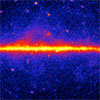| Apr 28, 2022 |
|
|
|
(Nanowerk News) Researchers from The Australian National University (ANU) have found an alternative explanation for a mysterious gamma-ray signal coming from the centre of the galaxy, which was long claimed as a signature of dark matter (Nature Astronomy, “Millisecond pulsars from accretion-induced collapse as the origin of the Galactic Centre gamma-ray excess signal”).
|
|
Gamma-rays are the form of electromagnetic radiation with the shortest wavelength and highest energy.
|
|
Co-author of the study Associate Professor Roland Crocker said this particular gamma-ray signal – known as the Galactic Centre Excess – may actually come from a specific type of rapidly-rotating neutron star, the super-dense stellar remnants of some stars much more massive than our sun.
|
|
The Galactic Centre Excess is an unexpected concentration of gamma-rays emerging from the centre of our galaxy that has long puzzled astronomers.
|
 |
| View of the gamma-ray sky. (Image: NASA/DOE/Fermi LAT Collaboration)
|
|
“Our work does not throw any doubt on the existence of the signal, but offers another potential source,” Associate Professor Crocker said.
|
|
“It is based on millisecond pulsars — neutron stars that spin really quickly — around 100 times a second.
|
|
“Scientists have previously detected gamma-ray emissions from individual millisecond pulsars in the neighbourhood of the solar system, so we know these objects emit gamma-rays. Our model demonstrates that the integrated emission from a whole population of such stars, around 100,000 in number, would produce a signal entirely compatible with the Galactic Centre Excess.”
|
|
The discovery may mean scientists have to re-think where they look for clues about dark matter.
|
|
“The nature of dark matter is entirely unknown, so any potential clues garner a lot of excitement,” Associate Professor Crocker said.
|
|
“But our results point to another important source of gamma-ray production.
|
|
“For instance, the gamma-ray signal from Andromeda, the next closest large galaxy to our own may be mostly due to millisecond pulsars.”
|


